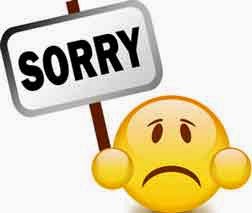Teachable moments occur in the course of each day ... Sometimes, the most important, authentic social learning comes from these moments.
Little ones are not born with the ability to know how to apologize. They benefit from you modeling how to do this, so that it becomes natural for them, and then can happen spontaneously in the future. When something happens between friends, siblings, or classmates that calls for an apology, look for your child's ability to stop and say the words or make the gesture. If they aren't able or ready, show them explicitly how to do this :) Just as we model other activities, we can teach accountability, apology, and work on empathy.
Teach your children that apologies are necessary and should be direct and specific. Model this with yourself, as well. When something goes wrong, as it sometimes will, and the teacher (or parent) makes a mistake - possibly attributing blame to the wrong person or misunderstanding a situation - use it as an opportunity to model, as well as to truly apologize.
All of the children who have passed through my classes know "even grown-ups make mistakes." Getting down to eye level, directing my attention to the small person involved, and saying specifically why I am sorry ... "I'm sorry I thought you were talking, when you were actually working so quietly ... can you forgive me? I'll try to look more carefully next time." This shows that child and all observing exactly what an apology should look like and sound like.
I think forgiveness also comes easier to those who know how to apologize. Once your child starts to see the impact of their actions, intentional or not, they also are better able to see their place in the group, and feel the power of forgiveness. A team dynamic in your home or classroom will help your child in many aspects of their lives.
So, have fun - and apologize when necessary!
Little ones are not born with the ability to know how to apologize. They benefit from you modeling how to do this, so that it becomes natural for them, and then can happen spontaneously in the future. When something happens between friends, siblings, or classmates that calls for an apology, look for your child's ability to stop and say the words or make the gesture. If they aren't able or ready, show them explicitly how to do this :) Just as we model other activities, we can teach accountability, apology, and work on empathy.
Teach your children that apologies are necessary and should be direct and specific. Model this with yourself, as well. When something goes wrong, as it sometimes will, and the teacher (or parent) makes a mistake - possibly attributing blame to the wrong person or misunderstanding a situation - use it as an opportunity to model, as well as to truly apologize.
All of the children who have passed through my classes know "even grown-ups make mistakes." Getting down to eye level, directing my attention to the small person involved, and saying specifically why I am sorry ... "I'm sorry I thought you were talking, when you were actually working so quietly ... can you forgive me? I'll try to look more carefully next time." This shows that child and all observing exactly what an apology should look like and sound like.
I think forgiveness also comes easier to those who know how to apologize. Once your child starts to see the impact of their actions, intentional or not, they also are better able to see their place in the group, and feel the power of forgiveness. A team dynamic in your home or classroom will help your child in many aspects of their lives.
So, have fun - and apologize when necessary!

